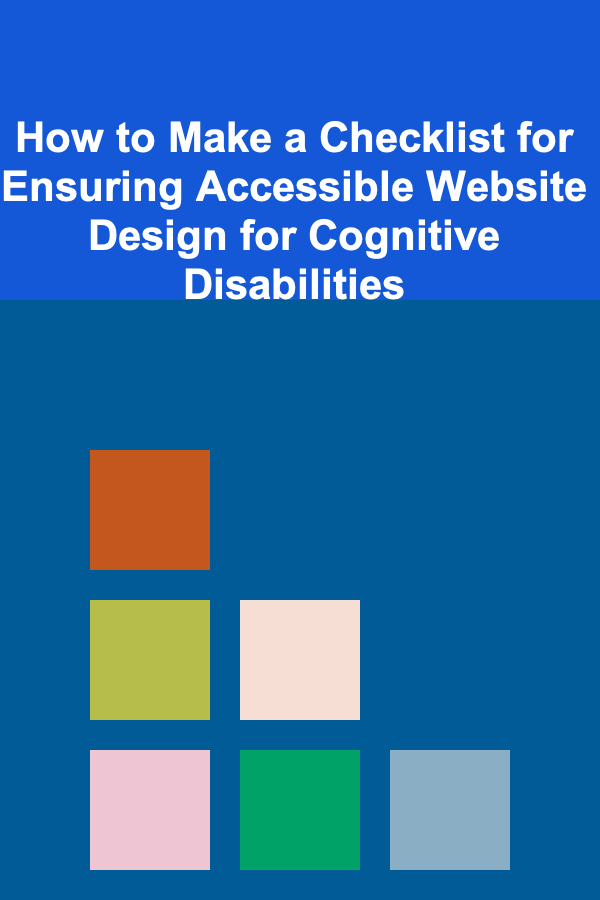
How to Make a Checklist for Ensuring Accessible Website Design for Cognitive Disabilities
ebook include PDF & Audio bundle (Micro Guide)
$12.99$11.99
Limited Time Offer! Order within the next:

Ensuring that websites are accessible to everyone, including individuals with cognitive disabilities, is crucial for creating inclusive digital experiences. Cognitive disabilities encompass a wide range of conditions, such as learning disabilities, attention deficit disorder (ADD), and memory impairments, which can affect how people interact with digital content. Designing websites with accessibility in mind is not only important for inclusivity but also essential for meeting legal requirements in many countries.
In this actionable guide, we'll explore how to create a checklist for ensuring that your website is accessible to people with cognitive disabilities, with practical steps you can take to enhance usability and accessibility.
Understand Cognitive Disabilities and Their Impact on Web Interaction
Before diving into creating a checklist, it's important to understand the types of cognitive disabilities and how they affect how individuals use websites. Cognitive disabilities can impact a person's ability to read, process, and understand information. Some common examples include:
- Dyslexia: Difficulty in reading and interpreting letters and words.
- Attention Deficit Disorder (ADD): Difficulty in maintaining focus or attention, especially in complex or crowded interfaces.
- Memory Impairments: Challenges with remembering information or instructions.
- Autism Spectrum Disorder (ASD): Sensitivity to overwhelming sensory input or difficulty with processing complex instructions.
Having an understanding of these conditions will help guide the design of your website and ensure that it meets the needs of users with these challenges.
Use Clear, Simple Language
One of the most important aspects of making a website accessible to individuals with cognitive disabilities is ensuring that the content is clear and easy to understand. Complex language, jargon, and long-winded sentences can be overwhelming, making it difficult for users to process the information.
Actionable Steps:
- Simplify Text: Use short, simple sentences. Avoid unnecessary technical terms or jargon.
- Be Direct: Be straightforward with instructions and descriptions. For example, instead of saying "Please ensure that you verify your account details before proceeding," say "Verify your account details."
- Use Bullet Points: Break down information into digestible chunks using bullet points or numbered lists.
- Include Plain Language Versions: If your content is complex, provide a plain language version or a summary.
Provide Consistent Navigation and Layout
Consistency is key for users with cognitive disabilities. A website with a predictable layout and consistent navigation helps users navigate more efficiently, reducing cognitive load and frustration.
Actionable Steps:
- Use Familiar Layouts: Stick to familiar web conventions. Place navigation menus, logos, and call-to-action buttons in predictable locations, such as the top of the page or on the left side.
- Keep Navigation Simple: Limit the number of menu items to avoid overwhelming users. A good rule of thumb is to keep primary navigation to around 5-7 items.
- Breadcrumbs: Use breadcrumb navigation to help users keep track of where they are on the site and easily move back to previous sections.
- Sticky Headers: Consider using sticky headers that stay visible as users scroll down the page, so they can easily access the main navigation without scrolling back up.
Ensure Clear Visual Hierarchy
A clear visual hierarchy makes it easier for users to distinguish between different types of content. By using design elements like color, size, and placement, you can create a layout that guides the user's eye in a logical order.
Actionable Steps:
- Use Headers and Subheaders: Use proper HTML heading elements (H1, H2, H3) to create a hierarchy of information. This allows users with cognitive disabilities to quickly scan and understand the structure of the page.
- Contrast and Color: Use high-contrast color schemes to ensure that text is readable for users with visual impairments and cognitive disabilities. Avoid relying solely on color to convey information (e.g., don't use only red text to indicate an error).
- Whitespace: Use whitespace effectively to separate different sections of content, reducing visual clutter. This helps users focus on the most important elements of the page.
- Emphasize Key Points: Use bold or italics to highlight important information but avoid overusing them as it can create distractions.
Include Text Alternatives for Multimedia Content
Multimedia content, such as images, videos, and audio, can pose barriers to individuals with cognitive disabilities if it is not properly described or captioned. Providing text alternatives for multimedia ensures that everyone can access the content, regardless of their cognitive abilities.
Actionable Steps:
- Alt Text for Images: Provide descriptive alt text for all images. Alt text should describe the purpose and content of the image. For example, for an image of a sign-up button, the alt text could be "Sign up for our newsletter."
- Captions for Videos: Provide captions for all videos to accommodate users who might have difficulty following along with the audio. This is particularly important for users with memory impairments or attention deficits.
- Transcripts for Audio: For audio content, provide transcripts to allow users to read the information if they have trouble processing the audio or if they are in an environment where they cannot listen to it.
- Audio Descriptions: For visually rich content, consider offering audio descriptions that narrate visual elements in videos or presentations.
Implement Clear and Predictable User Interactions
Users with cognitive disabilities may struggle with confusing or unpredictable interactions. It's essential that actions on your site are easy to understand and consistent throughout the user journey.
Actionable Steps:
- Use Clear Call-to-Actions (CTAs): Use clear, direct language for buttons, forms, and links. Instead of "Submit," use "Sign Up" or "Confirm Your Email," which provide a clearer idea of what the user is about to do.
- Minimize Form Complexity: If your website includes forms, make them as simple as possible. Limit the number of required fields, and use auto-fill and validation to reduce errors.
- Provide Feedback for Actions: When a user performs an action, provide immediate feedback. For example, if a user submits a form, show a confirmation message like "Your submission has been received."
- Provide Undo and Cancel Options: If users are able to make changes, give them the option to undo or cancel actions. This reduces the anxiety of making mistakes, which is especially important for users with cognitive impairments.
Test with Real Users
Testing with real users who have cognitive disabilities is one of the most effective ways to ensure that your website is accessible. While automated tools can catch many issues, human feedback will give you insights into how the site performs in real-world scenarios.
Actionable Steps:
- Conduct User Testing: Include individuals with cognitive disabilities in your user testing process. Observe how they interact with your website, paying attention to any areas where they experience difficulties.
- Use Focus Groups: Organize focus groups of users with various cognitive impairments to gather feedback on your website's usability and accessibility.
- Iterate Based on Feedback: Use the feedback from your users to make adjustments to the design. Keep iterating until you have a website that meets the needs of your target audience.
Provide Easy Access to Support
Providing easy access to help or support can make a big difference for users with cognitive disabilities who may need additional assistance navigating your site.
Actionable Steps:
- Offer Multiple Contact Options: Provide several ways for users to get in touch, including a helpdesk, live chat, or a dedicated email address.
- Use Help Tooltips: Consider using tooltips or pop-up help messages that provide additional context for users when they hover over specific elements on your site.
- Clear Support Information: Make sure your support information is easy to find and understand. Provide clear instructions on how users can access help or request assistance.
Conclusion
Designing websites with accessibility for cognitive disabilities in mind is essential for creating a more inclusive digital experience. By following these actionable steps, you can ensure that your website is usable and accessible for individuals with cognitive disabilities, from simplifying language and navigation to offering clear visual cues and multimedia alternatives. Keep testing and iterating based on real user feedback to ensure that your site remains accessible as it evolves.
With these strategies in place, your website will not only meet accessibility standards but will also be more user-friendly and welcoming for everyone, regardless of their cognitive abilities.
Reading More From Our Other Websites
- [Home Cleaning 101] How to Deep Clean Your Microwave in Minutes
- [Survival Kit 101] Best Ultra‑Lightweight Survival Kit for Solo Backpackers on the Pacific Crest Trail
- [Sewing Tip 101] Upcycle & Save: Transforming Household Items into Stylish Sewing Projects
- [Personal Care Tips 101] How to Use a Facial Scrub to Reduce Blackheads and Whiteheads?
- [Organization Tip 101] How to Choose the Right Furniture for Your Study Room
- [Personal Care Tips 101] How to Start a Plant-Based Diet
- [Skydiving Tip 101] Charting the Sky: Top Global Destinations for Competitive Skydiving Events
- [Home Soundproofing 101] How to Soundproof Your Ceiling to Minimize Noise from Above
- [Home Maintenance 101] How to Balance Modern Comforts with Historic Home Maintenance: A Guide to Sensitive Upgrades
- [Home Pet Care 101] How to Choose the Best Toys for Your Cat

How to Build a Checklist for Assigning Onboarding Tasks to Your Team
Read MoreHow to Create a Garage Inventory List for Easy Tracking
Read More
How to Create Signature Party Drinks That Wow Your Guests
Read More
How to Organize a Shared Workspace for Team Productivity
Read More
How to Perform Regular Home Security Inspections
Read More
How to Use Deep Learning to Automate and Maximize Your Passive Income
Read MoreOther Products

How to Build a Checklist for Assigning Onboarding Tasks to Your Team
Read MoreHow to Create a Garage Inventory List for Easy Tracking
Read More
How to Create Signature Party Drinks That Wow Your Guests
Read More
How to Organize a Shared Workspace for Team Productivity
Read More
How to Perform Regular Home Security Inspections
Read More